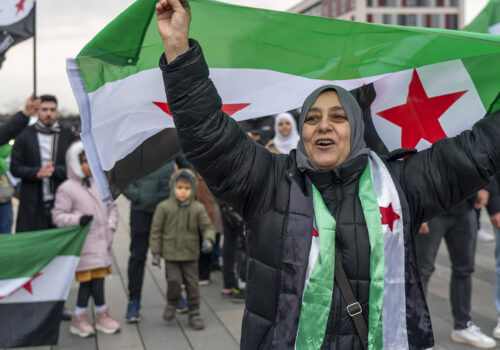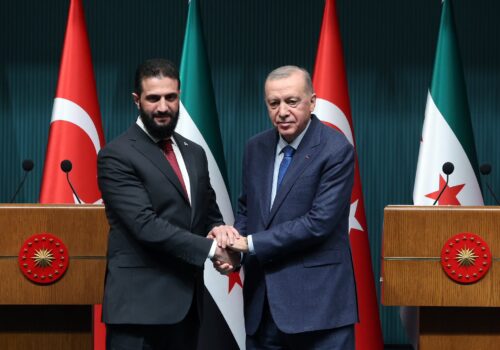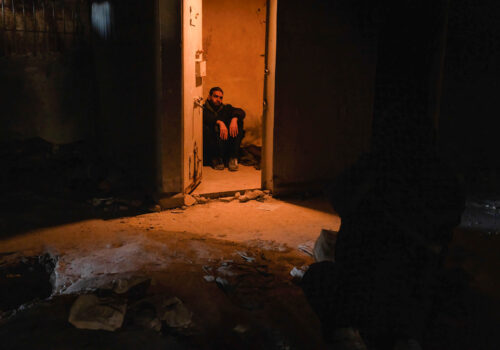Landmark SDF-Damascus deal presents opportunity, and uncertainty, for Turkey
The recent agreement between Syrian President Ahmed Sharaa and the Syrian Democratic Forces (SDF) commander, Mazloum Abdi, marks a turning point in Syria’s conflict dynamics. According to the deal, all civilian and military institutions in northeastern Syria will be integrated into the Syrian state, effectively dissolving the autonomous governance structures established by the Kurdish People’s Protection Units (YPG)-dominated SDF. This development has been met with widespread celebrations across Syria, symbolizing the country’s reunification under Damascus’s rule. This agreement appears to serve Turkey’s long-standing objective of dismantling the YPG-led autonomous administration and ending the conflict with the Kurdistan Workers’ Party (PKK) for good, but Ankara’s optimism remains cautious.
This agreement comes after the historic call by the imprisoned PKK leader Abdullah Öcalan for the dissolution of the PKK and all of its groups. After the Turkish nationalist leader Devlet Bahceli launched the initiative, the conflict between Turkey and the PKK is as close to an end as ever before. Ankara sees the agreement, signed on March 11, 2025, in Damascus, as a critical step towards this goal.
The most significant takeaway for Turkey is that it signals the formal end of the statehood project in northeastern Syria under the Democratic Autonomous Administration of North and East Syria. The YPG is the Syrian branch of the PKK, a designated terrorist organization by Turkey, the United States, and the European Union. By signing this deal, Mazloum Abdi has essentially conceded the collapse of the autonomous administration project. The absence of any reference to an autonomous region in the agreement and the fact that Abdi was addressed solely by name rather than his military title further reinforce this perspective.
Ambiguities that warrant caution
Despite the positive signals, two critical ambiguities within the agreement require scrutiny. The first pertains to the wording of Article 4, which states that all civil and military institutions in northeastern Syria will be “integrated” into the Syrian state.
The SDF initially demanded to join the Syrian army as a separate bloc, which led to a stalemate in the negotiations. Sources in Damascus told the author that the SDF won’t join as a separate bloc but that it will be dissolved, and its members will join the army individually. An interview by Mazloum Abdi indicates the same. The SDF has also accepted another key Turkish demand: for non-Syrian PKK cadres to leave Syria.
SIGN UP FOR THIS WEEK IN THE MIDEAST NEWSLETTER
However, certain SDF-affiliated voices are presenting an alternative reading, claiming that the SDF will retain its organizational structure while merely operating under the Syrian state’s framework. This contradiction suggests that some within the SDF may not be on board with the agreement or that the ambiguity in the agreement may cause disagreements in the future. Conflicting narratives such as these increase the risk of potential for non-compliance or future renegotiations.
The second major uncertainty lies in Article 8, which outlines a transition period for implementing the agreement, stating that a commission will oversee its execution by the end of the year. An eight-person committee has already been established. This prolonged timeline introduces risks, including potential backtracking by the SDF or external interference by third-party actors seeking to derail the process. The nine-month implementation period provides ample opportunity for complications to arise, whether due to internal resistance within the SDF, sabotage attempts by foreign powers, or operational difficulties in fully integrating SDF-controlled institutions into the Syrian state.
Strategic implications for Turkey
Syria has been a key in Turkey’s approach to the PKK, and from Ankara’s perspective, the agreement represents an opportunity. It aligns with Ankara’s goal of preventing the establishment of a semi-independent PKK entity on its southern border. But more importantly, the agreement furthers the Turkish strategy to convince the PKK to dissolve itself and end the terror threat towards Turkey.
On February 27, 2025 the imprisoned leader of the PKK made a historic call for the dissolution of the group. Following this call, the PKK declared a unilateral ceasefire and stated its readiness to discuss its dissolution. The pro-Kurdish Peoples’ Equality and Democracy Party (DEP) in Turkey has been a critical mediator during the process and fully supports the initiative. The last time Turkey tried a peace process with the PKK, it ended miserably with an escalation of violence inside cities in Turkey’s southeast. Between 2013 and 2015, Turkey tried a negotiated settlement with the PKK. This time, Turkey is acting differently.
This time, the Turkish counter-terrorism operations are not halted, and Ankara’s approach is that of a government victory against the PKK. The rationale is clear: the PKK’s strategy failed. Turkish military operations succeeded in eliminating all guerilla capabilities of the PKK inside Turkey, ended the PKK’s ability to infiltrate into Turkey via Iraqi Kurdistan, and cornered the PKK’s branch in Syria.
Geopolitical shifts in the Middle East elevate the Turkish position dramatically. The YPG-dominated SDF lost all of its territories on the western side of the Euphrates River and faces huge pressure in a post-Bashar al-Assad Syria. The SDF no longer receives Russian military protection or Iranian weapon supplies and no longer has an Assad regime to cooperate with against Turkey. Turkey now has an ally in Damascus and has managed to gain the support of Arab and European states for Syria.
The only remaining support the SDF enjoys is the US support against the Islamic State of Iraq and al-Sham (ISIS)and the Israeli strategy to divide Syria along sectarian and ethnic lines. Despite Israeli rhetoric, Israel is unlikely to support the SDF in a meaningful way and antagonize Turkey. The United States, under the administration of President Donald Trump, is unlikely to remain in Syria. To avoid a military operation by Turkey in a post-withdrawal scenario, the United States has reportedly pushed the SDF to reach an agreement with Damascus. The Trump administration only really cares about the ISIS angle. Knowing this, Turkey formed a security cooperation with Lebanon, Iraq, Jordan, and Syria to take over the anti-ISIS mission from the US-led international coalition. It was no coincidence that the SDF agreed to sign a deal with the interim Syrian authorities after the summit in Amman. It was unimaginable a year ago, but the Turkish and American approaches to SDF are currently overlapping.
From the domestic level to geopolitics, all stars appear to be aligned for Ankara. By allowing the PKK and affiliates to engage in legal politics in Turkey and Syria, Turkish decision-makers are very close to achieving a historic gain. The four-decade-long conflict may end.
That being said, the uncertainties surrounding the implementation necessitate continued vigilance. The most critical factor for Turkey is how the Syrian regime will handle the military integration of SDF forces. If the SDF leadership retains operational autonomy under the Syrian army’s banner, it could pose a continued security threat to Turkey. Turkey is not a party to the agreement, meaning it retains full flexibility in responding to any unfavorable developments.
Turkey’s strategy moving forward
Given the historic opportunity and the uncertainties, Turkey will adopt a three-layered strategy to ensure the implementation of the agreement aligns with its national security interests. First, Ankara will maintain its military pressure in northeastern Syria to deter any backtracking by the SDF. The Turkish government has consistently emphasized its readiness to intervene militarily in Syria if necessary, and this agreement does not alter that stance. The continuity of Turkish airstrikes against the SDF and the PKK are a reflection of this stance.
Second, Turkey will actively engage in diplomatic talks with Damascus and Washington to ensure that the agreement leads to a complete dissolution of the SDF’s military structure rather than a superficial rebranding. Back-channel diplomacy between Turkey and the United States, as well as American pressure on the SDF, was particularly essential in making this agreement possible. The American role will remain integral for the upcoming nine-month-long implementation phase.
Third, the PKK’s ultimate decision and action will be essential in shaping the agreement’s implementation. Therefore, the implementation phase in Syria will strongly depend on domestic Turkish political developments. The current narrative on a Turkish-Kurdish alliance is essential for the deal in Syria to continue. Furthermore, the PKK cadres in the Qandil Mountains in Iraq and Iran could reject Öcalan’s call. Even if the PKK accepts to dissolve itself, the process to do so remains unknown. Turkey’s approach to Syria’s northeast will be in sync with the developments regarding the PKK’s central and Turkish domestic politics.
Ömer Özkizilcik is a nonresident fellow for the Syria Strategy Project at the Atlantic Council’s Middle East Programs. He is an Ankara-based Turkish foreign policy, counterterrorism, and military affairs analyst.
Further reading
Mon, Mar 10, 2025
Syria’s women face a new chapter. Here’s how to amplify their voices.
MENASource By Diana Rayes , Hind Kabawat
It is critical for women to be involved in transitional justice and constitutional reform processes in Syria.
Wed, Feb 26, 2025
Why post-Assad Syria complicates the Iran-Turkey rivalry
MENASource By
Depending on what unfolds after Assad's fall, there could be reason to expect a degree of Iran-Turkey alignment in Syria.
Thu, Feb 13, 2025
Dispatch from Syria: ‘Syrians cannot focus on their future if they are still drowning in their past’
MENASource By Arwa Damon
The pain felt by those searching for clues in the dark void of the former regime’s detention system is palpable, Arwa Damon reports from Syria.
Image: Syria's interim President Ahmed al-Sharaa and Commander of Syrian Kurdish-led forces Mazloum Abdi shake hands, after Syria reached a deal to integrate the Kurdish-led Syrian Democratic Forces (SDF) with state institutions, the Syrian presidency said on Monday, in Damascus, Syria, in this handout released on March 10, 2025. SANA/Handout via REUTERS ATTENTION EDITORS - THIS IMAGE WAS PROVIDED BY A THIRD PARTY. REUTERS IS UNABLE TO INDEPENDENTLY VERIFY THIS IMAGE. TPX IMAGES OF THE DAY



